Место спасения или мучения: образ Русской православной церкви в светских СМИ во время пандемии COVID-19
DOI:
https://doi.org/10.14515/monitoring.2020.6.1748Ключевые слова:
медиатизация, Русская Православная Церковь, светские медиа, цифровизация, социальные стереотипыАннотация
В работе «Медиатизация и религия» С. Хьярвард отметил, что становится все труднее контролировать публичные репрезентации религии в СМИ. Сложность заключается в том, что религиозные СМИ, религиозная журналистика и «повседневная религия» говорят на разных языках. Во время пандемии среди верующих и неверующих разгорелись споры о том, закрывать ли церкви и приходы на период карантина. По указу патриарха все службы в храмах должны были совершаться без участия прихожан. Не остались в стороне от обсуждения этого вопроса и светские СМИ. В нашем исследовании мы проанализировали ряд текстов (статей) трех крупных новостных порталов. Это портал «Фонтанка» (региональный уровень, Санкт-Петербург), портал газеты «Аргументы и факты» (федеральный уровень) и портал газеты «Московский комсомолец» (региональный уровень, Москва). Статьи анализировались за период с 15 марта по 15 июня 2020 г. Основной рабочей гипотезой было предположение, что имидж Русской православной церкви (РПЦ) в светских СМИ будет меняться в зависимости от действий самой Церкви во время пандемии, но в целом воспроизводиться скорее в негативном ключе. Данные контент-анализа подтвердили эту гипотезу как для СМИ, так и для их аудитории. Желание РПЦ вести богослужения во время пандемии было расценено в СМИ как вредительство, угрожающее жизни прихожан. РПЦ в период пандемии активизировала процесс цифровизации взаимодействия с паствой.
Загрузки
Опубликован
Как цитировать
Выпуск
Раздел
Лицензия
Copyright (c) 2020 Мониторинг общественного мнения: экономические и социальные перемены

Это произведение доступно по лицензии Creative Commons «Attribution-NonCommercial-ShareAlike» («Атрибуция — Некоммерческое использование — На тех же условиях») 4.0 Всемирная.






